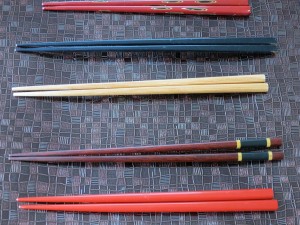 In Japan, there are a few etiquette rules when using chopsticks. Although I grew up in a Japanese-American home, there were some rules that my Japanese girlfriends kindly pointed out to me because I did a few of the taboos, simply out of ignorance. Here are a few that I think are good to know.
In Japan, there are a few etiquette rules when using chopsticks. Although I grew up in a Japanese-American home, there were some rules that my Japanese girlfriends kindly pointed out to me because I did a few of the taboos, simply out of ignorance. Here are a few that I think are good to know.
First, a basic reminder: chopsticks are utensils. Because it’s just a set of two sticks, we often forget this fact as it easily morphs into all sorts of things such as drum sticks, weapons, toys, pointers and anything one can imagine when having too much to drink! Just make sure you chose the right time and place to act silly. Also, with the creative minds of children, they often find that mealtime can be boring if the menu isn’t to their liking. Chopsticks become great entertainment tools. However, it may be best to restrict their creativity at a young age in this situation. In Japan it’s considered bad manners to play with your chopsticks at the dinner table.
Do
- The proper way to hold chopsticks is to have them parallel to each other. Although, initially, some find that crossing chopsticks to pick up items may be easier, with practice you learn that keeping them parallel offers more control. Practice, practice, practice
- If a chopstick rest is provided, place the tips on the rest. Click here for the short video I made: How to make a chopstick rest.
Don’t
- Sashi bashi: Sashi means to stab, therefore, it is considered impolite to stab your food with chopsticks, although sometimes it is understandable, especially for small children. Try to separate a large piece with the tips of your chopsticks. Better yet, get a knife and cut into smaller pieces.
- Tate bashi/Hotoke Bashi: Tate comes from the word tateru, meaning to stand. Hotoke means buddha or spirit, and so it symbolizes how incense is offered to the spirits. This means do not poke your chopsticks in your rice bowl to make them stand upright. This gesture is done during funerals, so is considered inauspicious.
- Hiroi bashi: Hirou means to pick up. Do not pass food from chopstick to chopstick. Again this is done during funerals when passing bones, so it’s taboo.
- When eating from communal dishes that are shared with everyone at the table, usually, a separate set of serving chopsticks or a spoon is provided. Make sure you use this. However, if it isn’t available, flip you chopsticks around and use the opposite end that has not been touched by your mouth to place food in your plate.
- Neburi bashi: Don’t suck, chew, or lick the tips of your chopsticks.
- Yose bashi: Yoseru means to pull something close to you. Don’t use your chopsticks as a tool to pull a bowl or plate closer to you. As in any culture, ask someone to pass you a plate.
These are just a few simple chopstick rules that you can apply right away. When you are unsure of the customs or are having difficulty, just ask for help. Everyone will happily give you guidance and will commend you for your efforts!



Excellent article, Jenny! Thanks for helping us get the word out and bring Snappy Chopsticks to the World! Cheers, Ben
The Chopstick Store . Com
Numerous online customers are searching for Amico 10 Pairs 9.4″ Long Wood Color Wave Pattern Home Kitchen Bamboo Chopsticks as of late. I suppose you are likewise one of them, aren’t you? I’ve to let you know that you have gone to the right site.
Numerous online customers bamboo chopsticks are searching for Amico 10 Pairs 9.4″ Long Wood Color Wave Pattern Home Kitchen Bamboo Chopsticks as of late. I suppose you are likewise one of them, aren’t you? I’ve to let you know that you have gone to the right site.